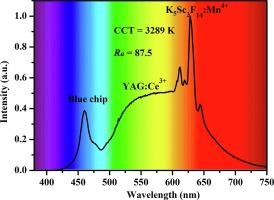Mn4+-activated Sc-based hexafluoride red phosphor K5Sc3F14: Synthesis, luminescence, and its applications in blue-pump WLEDs
IF 4.3
2区 化学
Q1 SPECTROSCOPY
Spectrochimica Acta Part A: Molecular and Biomolecular Spectroscopy
Pub Date : 2024-11-03
DOI:10.1016/j.saa.2024.125382
引用次数: 0
Abstract
Due to the advantages of low phonon energy, structural diversity, excellent thermal stability and optical properties, fluoride compounds have sparked considerable research attention. On this foundation, a novel red-emitting phosphor, K5Sc3F14:Mn4+ (abbreviated as KSF:Mn4+), was successfully designed and synthesized via a conventional co-precipitation process. The phosphor was comprehensively analyzed in terms of its phase, structure, morphology, elemental composition, and optical performance. Under blue light (473 nm) excitation, seven discernible emission peaks appear at 599, 609, 613, 622, 630, 634, and 647 nm, which can be attributed to the 2Eg to 4A2g transition of the Mn4+ ions. Furthermore, the optimal molar ratio of K5Sc3F14:K2MnF6 and crystal-field parameters (CFPs) are amply discussed. Ultimately, a warm WLED lamp with a high CRI (Ra = 87.5) and a low CCT (3289 K) was successfully created through the combination of a synthesized KSF:Mn4+ phosphor and a well-known YAG:Ce3+ phosphor, demonstrating that the developed phosphor is an appealing red component for high‐performance warm white illumination.

Mn4+激活的Sc基六氟化红荧光粉K5Sc3F14:合成、发光及其在蓝泵WLED中的应用。
由于氟化合物具有声子能量低、结构多样、热稳定性和光学性能优异等优点,因此引发了广泛的研究关注。在此基础上,通过传统的共沉淀工艺,成功设计并合成了一种新型红色发光荧光粉 K5Sc3F14:Mn4+(简称 KSF:Mn4+)。对该荧光粉的相态、结构、形态、元素组成和光学性能进行了全面分析。在蓝光(473 nm)激发下,在 599、609、613、622、630、634 和 647 nm 处出现了七个可辨认的发射峰,这可能是由于 Mn4+ 离子的 2Eg 向 4A2g 转变所致。此外,还充分讨论了 K5Sc3F14:K2MnF6 的最佳摩尔比和晶体场参数 (CFP)。最终,通过将合成的 KSF:Mn4+ 荧光粉和著名的 YAG:Ce3+ 荧光粉相结合,成功地制造出了具有高显色指数(Ra = 87.5)和低 CCT(3289 K)的暖白光 WLED 灯,这表明所开发的荧光粉是一种用于高性能暖白光照明的极具吸引力的红色成分。
本文章由计算机程序翻译,如有差异,请以英文原文为准。
求助全文
约1分钟内获得全文
求助全文
来源期刊
CiteScore
8.40
自引率
11.40%
发文量
1364
审稿时长
40 days
期刊介绍:
Spectrochimica Acta, Part A: Molecular and Biomolecular Spectroscopy (SAA) is an interdisciplinary journal which spans from basic to applied aspects of optical spectroscopy in chemistry, medicine, biology, and materials science.
The journal publishes original scientific papers that feature high-quality spectroscopic data and analysis. From the broad range of optical spectroscopies, the emphasis is on electronic, vibrational or rotational spectra of molecules, rather than on spectroscopy based on magnetic moments.
Criteria for publication in SAA are novelty, uniqueness, and outstanding quality. Routine applications of spectroscopic techniques and computational methods are not appropriate.
Topics of particular interest of Spectrochimica Acta Part A include, but are not limited to:
Spectroscopy and dynamics of bioanalytical, biomedical, environmental, and atmospheric sciences,
Novel experimental techniques or instrumentation for molecular spectroscopy,
Novel theoretical and computational methods,
Novel applications in photochemistry and photobiology,
Novel interpretational approaches as well as advances in data analysis based on electronic or vibrational spectroscopy.

 求助内容:
求助内容: 应助结果提醒方式:
应助结果提醒方式:


